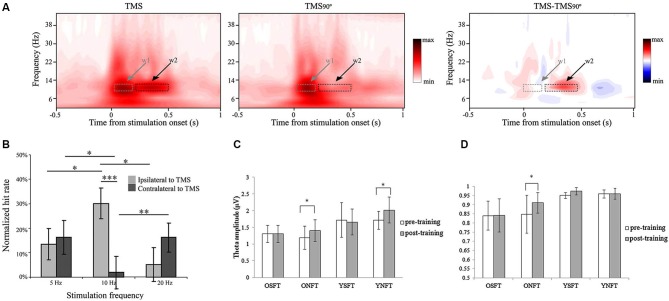Figure 3.
Examples of manipulating neuronal oscillations and their impact on cognition. (A) rTMS stimulation at 10 Hz to right parietal cortex results in alpha oscillations outlasting the stimulation period (t = 0 s), compared to the control condition of rotating the TMS coil by 90° (TMS90). The condition contrast with other control conditions confirmed the exclusive effect of rTMS at 10 Hz. w1 = time window of the first two pulses and w2 = time window of the last three pulses. Reproduced with permission from Thut et al. (2011b). (B) 10 Hz rTMS stimulation, but not 5 or 20 Hz, of parietal cortex ipsilateral to stimulation results in behavioral improvement, whereas contralateral stimulation results in decreased performance (* p < 0.05, ** p < 0.01, *** p < 0.001). Reproduced with permission from Romei et al. (2010). (C) Frontal theta neurofeedback training results in increased frontal theta in both young and old adults. OSFT = old subjects, sham feedback; ONFT = old subjects, neurofeedback group; YSFT = young subjects, sham feedback; YNFT = young subjects, neurofeedback (* p < 0.01). Taken with permission from Wang and Hsieh (2013). (D) Only old adults receiving neurofeedback on frontal theta increased working memory accuracy in a Sternberg task (depicted on the y-axis). Young adults were already performing at ceiling level. (for acronym, see panel C; * p < 0.01). Taken with permission from Wang and Hsieh (2013).

